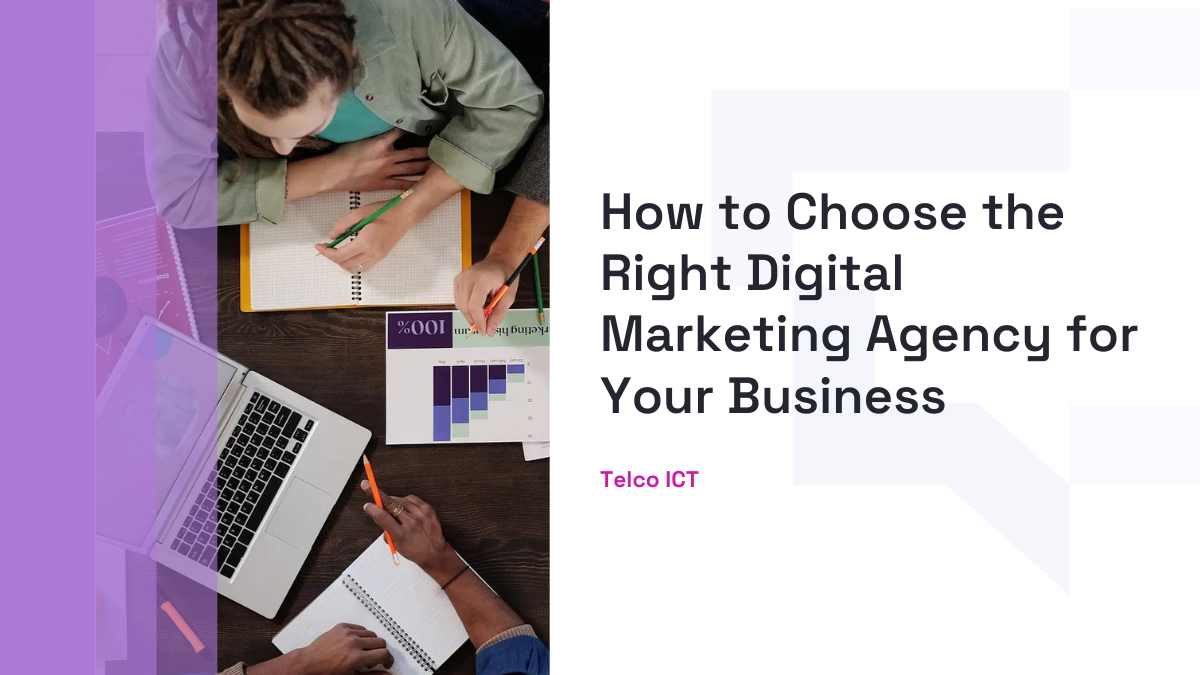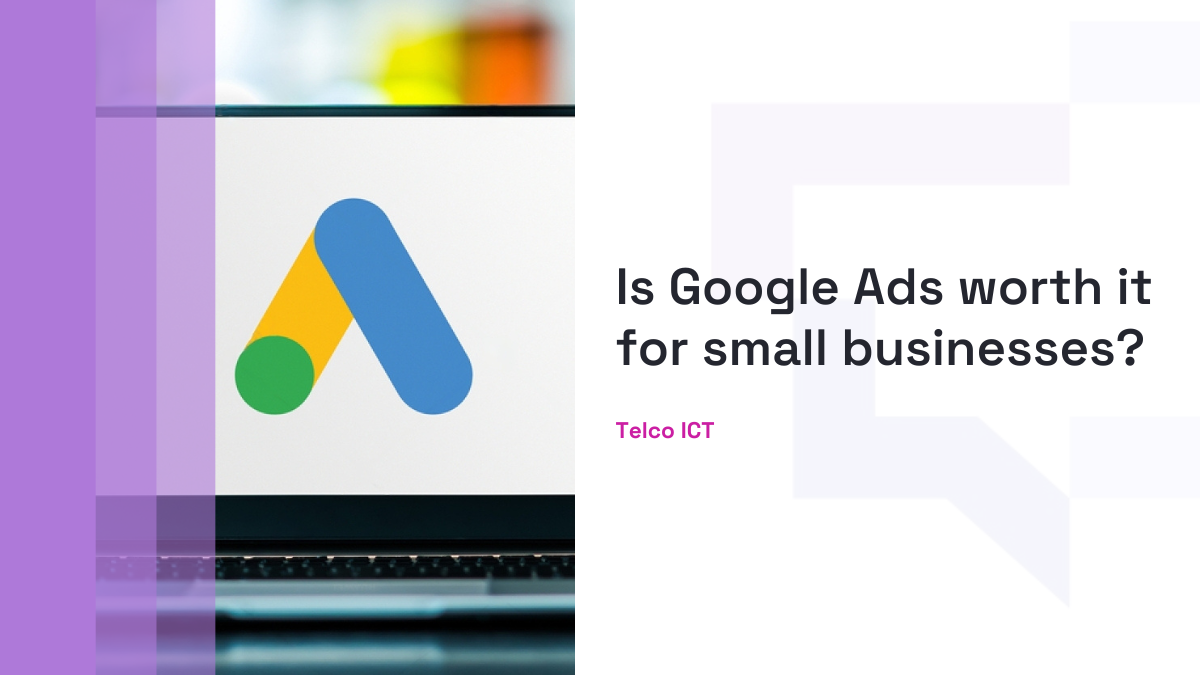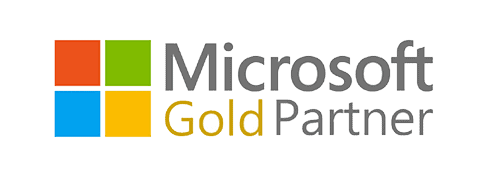All Posts / 5 Secret Settings to Unlock the Full Potential of Google Ads
Digital Strategy
5 Secret Settings to Unlock the Full Potential of Google Ads
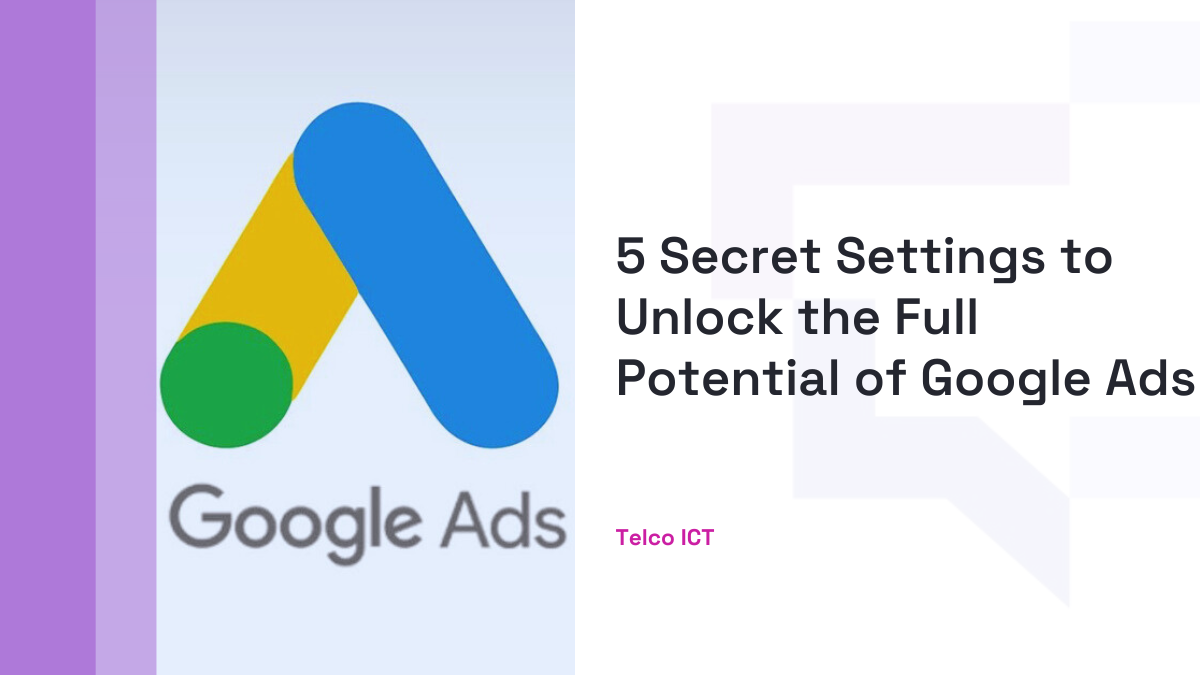
In today’s digitally savvy business environment, Google ads are the best way to get your business out there.
Google gets over 3 billion searches every single day. With all this traffic, imagine what it can do to your business if it was well-positioned for your target audience. Exciting, right?
This could mean increased exposure, interactions, and even sales.
The basic operation of Google Ads is simple. When users enter a keyword, a search engine results page (SERP) displays the findings of their inquiry. One of those outcomes might be a paid ad that specifically targeted that keyword.
When users search for relevant terms, Google Ads allows you to advertise and promote your goods and services. It has the potential to accelerate leads and sales when done correctly.
As much as Google ads are there to help you, you must be cunning in the way you set up your ads to stand out. You do not want to be in a situation where you have spent a fortune in running ads but still not hitting your target.
That is why we have specifically curated these 5 Google Ads secrets that will help you unlock the full potential of your Google ads. Let’s start with some Google Ads tips that will make you a better advertiser.
How does Google Ads work?
How Google Ads work is pretty simple. Just because you have run your ad, it doesn’t guarantee that your ad will be displayed. Here’s how it works!
Google uses PPC advertising, and when a user types in a keyword that you are targeting, Google runs an auction where the best ad wins. But what determines the best ad?
When a user enters a search query with a certain keyword, all advertisers that are targeting the same keyword place bids against other advertisers who are using the same keyword.
A pay-per-click business model governs Google Ads. That indicates that advertisers use Google to target a certain keyword and place bids against other advertisers who are using the same keyword.
Your bids are “maximum bids,” or the most amount you’re willing to spend on an advertisement.
For instance, if your maximum bid is $6 and Google deems that your cost per click is $3, you will be given that ad spot! You do not get the ad location if they decide it costs more than $6.
As an alternative, you can choose a maximum daily budget for your advertisement. You won’t ever spend more than a predetermined amount every day on that advertisement, which will help you determine the appropriate budget for your advertising campaign.
Important Elements of a Google Ad Campaign
Any successful ad must contain some of these elements. They are the building blocks that help your ad hit the desired target.
1. Targeting Options
Before running an ad, you must have an idea of who your target audience is.
To efficiently target particular audiences, Google Ads provides a variety of targeting choices. Advertisers can narrow down their target markets by using:
- Demographics e.g age and gender
- Geography
- Interests
- Behavior
- Gadgets.
By making use of these targeting options, you can make sure that your adverts are displayed to the audience that is the most likely to convert.
Keywords
A Google AdWords (now called Google ads) campaign heavily relies on keywords.
When people do pertinent searches on Google, these are words or phrases that they use in their search query. Advertisers select from these words and then start displaying their advertising.
A good ad requires you to choose the relevant words for your business. This is because it affects whether your advertising is shown to the intended audience. Google ads have different match types including:
- Broad match
- Phrase match
- Exact match
- Modified broad matches
This gives advertisers complete choice over the level of targeted precision.
2. Ad Groups
In the world of advertising, there are times some of the keywords you plan to use are sort of linked. In such a case, Google ads give a provision for such in the form of Ad groups.
Ad groups are collections of closely linked keywords. They give your ad some form of structure because they help you efficiently organize and structure your campaign. Putting keywords into ad groups raises the quality score of the ad, which affects the cost-per-click (CPC) and ad rank.
You should have a clear theme or focus for each ad group so that you can make ads that are incredibly relevant to the group’s keywords.
3. Ads
The ads are also creative elements on their own. Yes, you read that right.
The creative component that people view when their search query matches your specified keywords is the actual ad.
Every ad group in a Google Ads campaign often contains several ads, each of which is targeted to a different search intent. These ads are made up of:
- The headline
- The display URL
- The description lines.
To perfect your pitch and raise click-through rates, you can experiment with various ad formats, such as responsive search advertisements and expanded text ads.
4. Ad Extensions
Ad extensions are like the extra mile that you have to go for your ad to perform.
They include extra texts or links that will increase the visibility and relevance of your ad. With these extensions, you can expand your ad coverage and enhance your ad’s performance by far. Some of these ad extensions include:
- The site link extensions, which are extra links to specific pages on your website
- The callout extensions highlight important selling points
- The structured snippet extensions. They are for showcasing particular categories or services.
5. Landing Pages
Landing pages are like your business’ resume. By the look of your landing page, a customer can easily decide if you are qualified enough to fulfill their needs.
Simply put, a landing page is the page that users “land” on after clicking on your ad.
Landing pages are a crucial component of a successful campaign, even if they are not directly a part of the Google Ads interface.
It’s crucial to design landing pages that offer a seamless user experience and are pertinent to the ad content. Conversion rates and campaign success may both be considerably impacted by a well-designed landing page with a clear call-to-action (CTA).
6. Bidding and Budget
There’s always a cap for what your business is willing to spend on ads. You cannot wake up one day and decide to run ads without proper budgeting. Google ads itself requires you to have a daily budget that you are willing to spend on ads that day. As we had seen earlier, the auction system requires you to have a maximum bid, which is the maximum amount of money you’re willing to spend on an ad.
The highest price an advertiser is willing to pay for a click on their ad is represented by the bid. Setting a daily or campaign budget is essential to keep expenses under control in addition to bidding.
You can always choose to assign specific budgets to individual campaigns or the entire account in Google Ads. This will ensure that your money is well spent on actual results.
Unlocking the Full Potential of Google Ads: A Comprehensive Guide
Google Ads has become a major force in the world of Internet marketing in today’s fast-paced digital environment.
Google Ads provides companies of all sizes with an unrivaled opportunity to interact with their target audience. It has been able to spur growth like never before thanks to its broad reach and precise targeting features.
As we have established before, Google ads enable marketers to design effective Ad campaign settings that will help your ad to be prominently shown in Google search results and on a variety of partner websites.
However, if the full potential of these ads is not harnessed properly, your business will likely not achieve its goal. That is why in this section, we look into the top 5 secrets that will help you in Google Ads optimization, irrespective of the size of your business. But first, let’s look at the importance of Google Ads in your digital marketing journey.
- Enhanced Brand Visibility: Google Ads assist increase brand recognition and credibility by ranking at the top of search results, earning the trust of prospective customers.
- Cost-Effectiveness: Because Google Ads uses Pay-per-click strategies, you only pay when a customer clicks on your advertisement.
- Increased Website Traffic: Google Ads sends targeted visitors to your website, increasing its visibility and clientele.
- Results that are Measurable: With thorough analytics and tracking tools, you can gauge the effectiveness of your campaigns and make adjustments for the best possible return on investment.
- Capture the exact targeted audience: Targeting precise demographics, hobbies, and behaviors is possible with Google adverts, ensuring that the most appropriate audience sees your adverts.
How to Change Campaign Settings in Google Ads
Before devouring the 5 secrets that will skyrocket your Google Ad potential, let’s look at how to actually make setting changes in Google Ads. Here’s a step-by-step guide:
- Log in to your Google Ads account first. Then, select Settings from the page’s left-hand menu as shown below:
- Secondly, choose the campaign you want to work on after that, then click the setting you want to modify. See below:
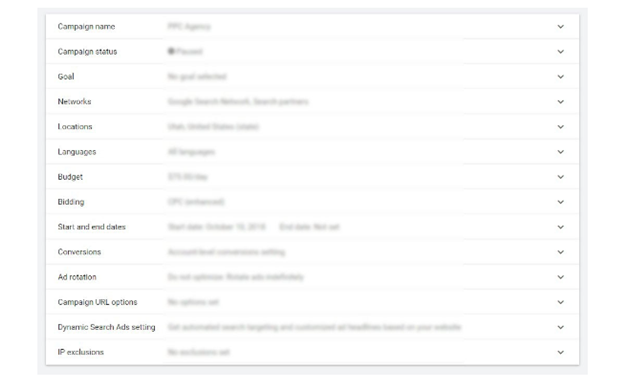

After these two steps, you are now free to make your adjustments. Always remember to hit save when finished.
5 Secret Settings to Unlock Full Potential of Google Ads
These five secret Google Ads settings that we discuss here can take your Google Ads campaigns to the next level. From targeting options to ad extensions, take this chance to optimize your ad performance and increase ROI with Google Ads. Get ready to supercharge your Google Ads strategy and achieve outstanding results!
1. The Location settings
In Google Ads, location is the very basic of the things you need to get right. Just like in Karate, it doesn’t matter how hard you kick if you miss the target.
If you wish to target the entire country, it’s alright that Google Ads’ default setting is set to Australia. For more precise Google Ads targeting, follow the following steps:
- Choose Enter another location like shown below:
- From here, enter locations using the search bar or select “Advanced search” to access a myriad of options.
- Include or omit places, use radius targeting, and add locations in bulk inside the advanced search window.
- The capability to choose locations by clicking straight on the map is one of the least well-kept secrets.
- By selecting “Show all areas” in the top-right corner of your map, you can enable this option.
- Once you’ve enabled this functionality, you may customize how the dropdown is used to select places. You have the following selections:
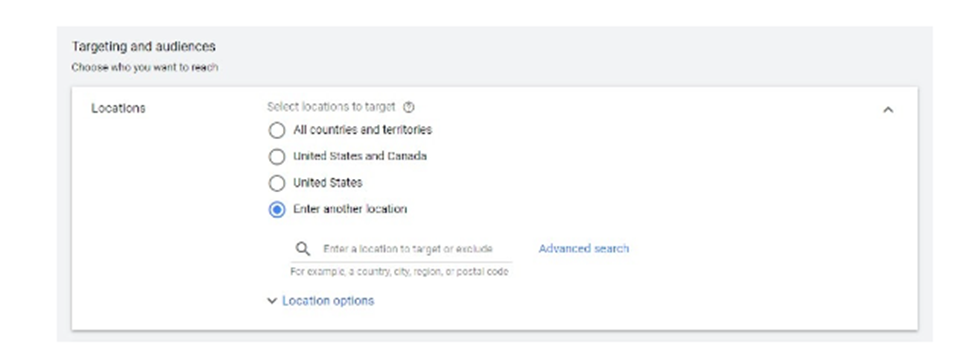
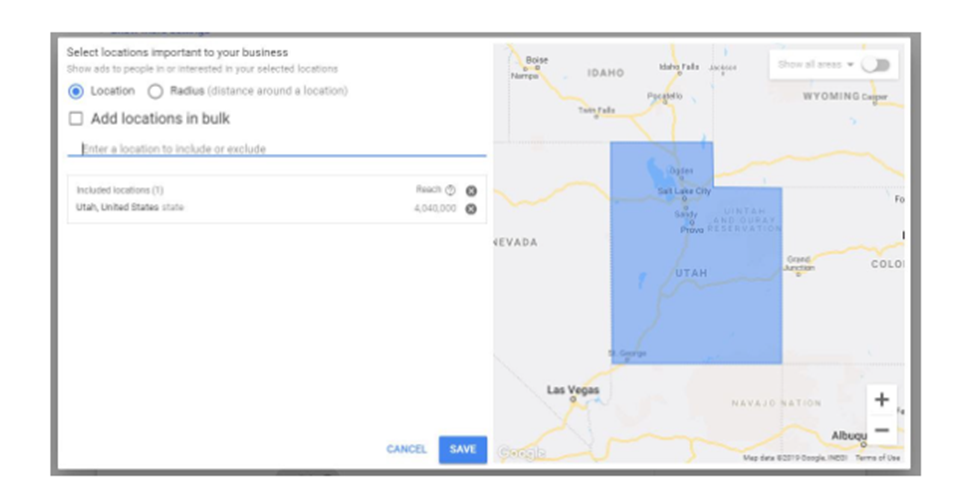
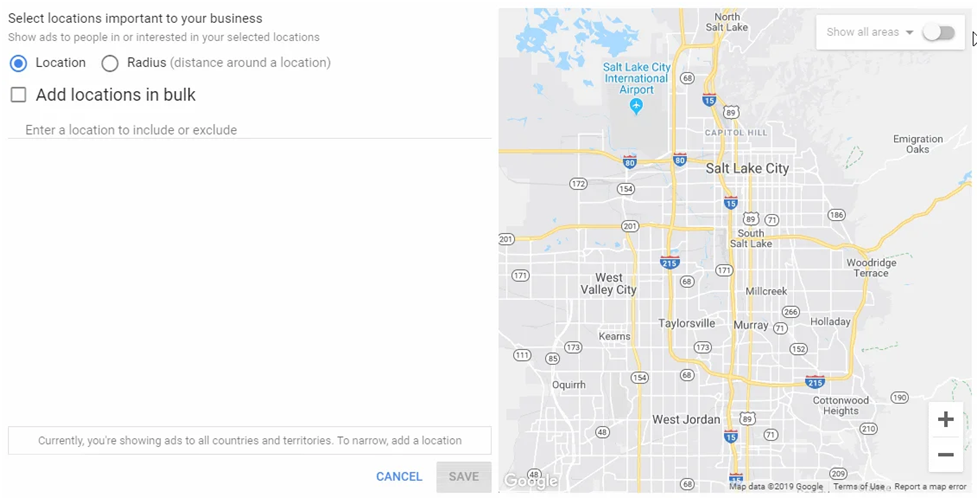
- Country
- University
- Postal Codes
- City
- Airport
- Neighborhood
- Congressional District
After that, the map will be divided appropriately. Clicking on the locations you want to include or exclude is all that is necessary.
When you wish to focus on areas in new places, do this; it should spare you the time of constantly looking up new zip codes.
Target with a radius
We must mention radius targeting in addition to the other fundamental location parameters.
With Google Ads’ radius targeting tool, you may define a targeting area around a particular location.

So when is radius targeting appropriate? Any firm that needs clients to travel to a physical location benefits greatly from radius targeting. Additionally, it is helpful for businesses with a small service area and mobile clientele.
So what happens when customers travel up to 40 kilometers to see your physical location? Should you simply add a second 30- or 40-mile ring to your target?
In this case, you can always change your setting knowing that your ad will run effectively. Read further to see how!
Setting Location Targeting for Areas More Than 20 Miles Away
Brick-and-mortar stores frequently have a wider “customer radius” when they are located in large cities or suburban areas that are connected by major highways. Often, businesses prefer a more focused strategy rather than a bigger region in all directions.
Instead of increasing your bullseye radius targeting in this situation, think about exploring cluster targeting.
Set the radius to 5 miles, activate pin mode, and then let loose.
Seriously, make several clusters along the city’s main commuter routes using the same radius targeting technique.
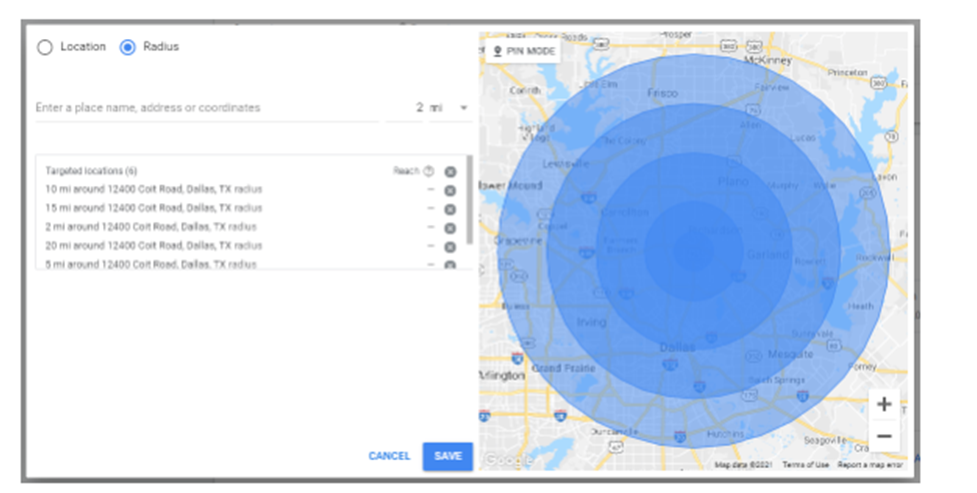
On that note, there are a few things to keep in mind:
- Consider your ideal consumer persona as an example. There will be variations in the region you target, such as socioeconomic status. Let Google do the legwork to identify which neighborhood in the city best fits your ideal customer.
-
Then, using your 5-mile pin tool, extend it into suburban areas along major roads where customers still frequent your establishment.
-
Then, set the radius to 15 miles and enter your precise location. Use a cluster of 10, 5, and 2 miles again. When you view the map you made, you might feel a little perplexed, but Google won’t. Giving Google every piece of segmented information it could ask for is the goal.
2. Winning Ad bidding strategies
There are currently nine alternative bidding tactics available, which can be extremely confusing. Focus on the manual and automated bidding tactics for the time being.
- The Automated: Based on the information they gather, Google automatically modifies your offers. Additionally, they determine the cost of clicks.
- The Manual: You choose how much to pay for clicks and establish your own keyword-level bids. Manual CPC is one of your manual bidding tactic choices.
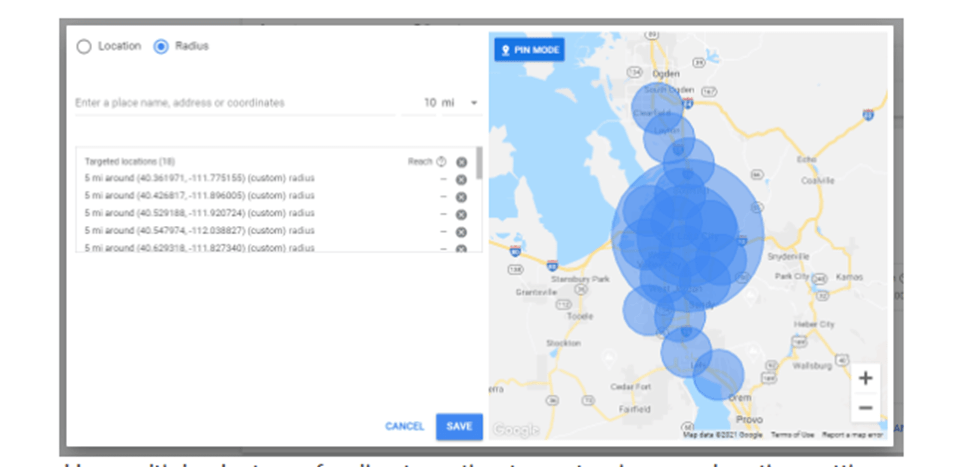
Please note that the use of automated bidding techniques is promoted as a time-saving alternative to spending hours manually modifying your bids. Furthermore, Google has significantly improved these techniques, which rely on real-time signals with which we frequently can’t compete.
Even though automated bidding will save you time, there are a few circumstances when human bid settings may still be the most beneficial.
3. You’ve got a fresh account.
New accounts also have no conversion data, which is essential if you want to maximize your ad spend and reduce your cost per click (CPC). Before implementing an automated or Smart Bidding method, give your account a month or two to gather the necessary data.
4. There is an epidemic of automated bidding.
If you notice that an automatic bidding strategy is diverging from your objective, manual CPC is always an alternative. Simply reverse the switch to regain better control.
To enable manual bidding, you’ll need to make a few minor modifications because Google Ads will by default use an automated bidding approach.
Select a bid plan immediately by clicking first. Open the dropdown and choose Manual CPC from the list after that. Last but not least, uncheck the box to turn off Enhanced CPC.
5. The Objective of the Campaign
Set your campaign goal first when you start a new campaign.
You can choose from one of the seven settings that Google Ads offers you.
Every campaign goal stands for a particular set of guidelines designed to help you manage your Google Ads campaign more effectively. The performance of your account is unaffected by the target you choose. Later on, though, it will restrict the choices for ad formats.
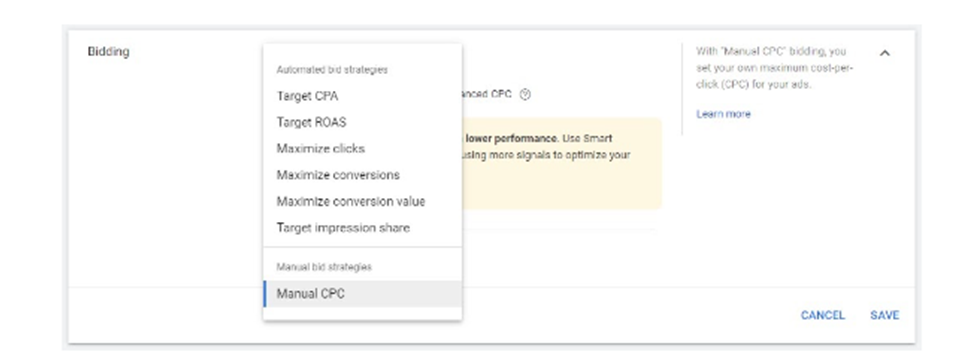
- Sales – Offers suggestions for modifying your budgeting and bidding techniques to attract more potential consumers’ clicks.
- Leads: Offers suggestions for enhancing audience targeting, ad extensions, and leads.
- Website Traffic – Guides you through the process of setting up dynamically produced headlines, extensions, and bidding techniques that can enhance traffic.
- Consideration of Products and Brands – Offers guidance on automated bidding, targeting, and visually appealing ads that encourage interaction.
- Brand Awareness and Reach – Advice on how to come up with eye-catching visual ads and bid tactics that will draw in more viewers.
- App Promotion – Recommends adjustments to bidding tactics that could result in an increase in clicks and possibly even app downloads.
- Focus on in-person visits and promotions at neighborhood stores.
- Campaign Creation Without Goal Guidance – Create your own path.
6. Accurate Ad extensions for Google Ads
What if you could increase the size of your adverts without incurring additional costs? Ad extensions will essentially accomplish that for you.
One of the finest strategies to raise your click-through rates (CTR) and optimize campaign effectiveness is without a doubt using Google ad extensions. Ad extensions are extra lines of text that display beneath the description of your ad. They enlarge and draw more attention to your ad as a result of search results. Here’s an example of a seller rating extension
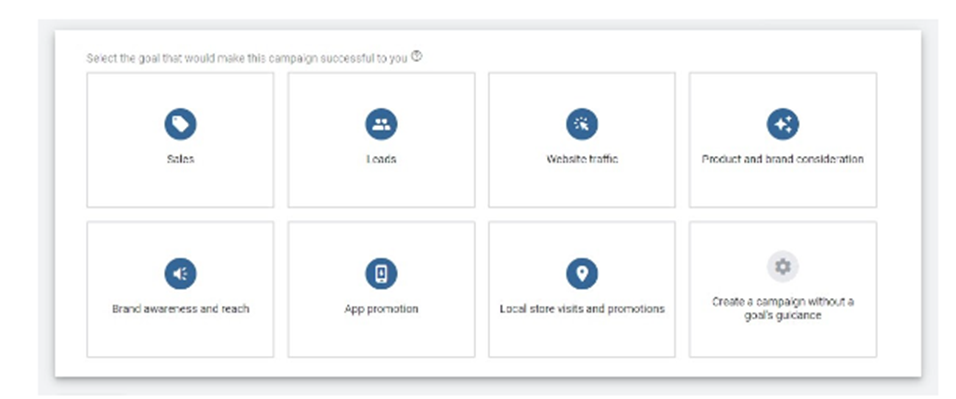
Searchers are more likely to click on your advertisement if it is more prominent. As a result, practically all of your key performance indicators improve thanks to higher CTR, reduced CPC, and lower costs per conversion.

The three major extensions offered by Google ads include:
- Sitelinks: Include extra links beneath the primary text link in search results; site links point users to key pages on your website.
- Structured extensions: Structured snippets provide searchers with a peek at the specifics you believe your clients would value the most.
- Callout extensions: These are 25-character sentences that highlight the most intriguing and valuable aspects of your company.



7. Exclusion of IP Addresses
You can exclude a certain IP address from viewing your adverts using IP exclusions.
These exclusions can be especially helpful if you suspect your rivals are clicking on your adverts. To avoid mistakenly viewing your own adverts and skewing the statistics, it is also a good idea to exclude your IP address.
There are cases where some firms decide to hire individuals solely to click on the advertisements of their rivals. The outcome? Thousands of dollars squandered on advertising, plus a budget that normally runs out first thing in the morning and your competitors’ ads start to appear. IP exclusions will save you from this madness.
But how can we determine whether this is necessary? Utilize the tool for ad preview and diagnosis.

Once the initial setup is complete, you can add IP exclusions to your Google Ads campaign. Go to your campaign settings, click further settings, then choose IP exclusions to configure them. After entering the IP addresses you want to block, click “Save” to finish.
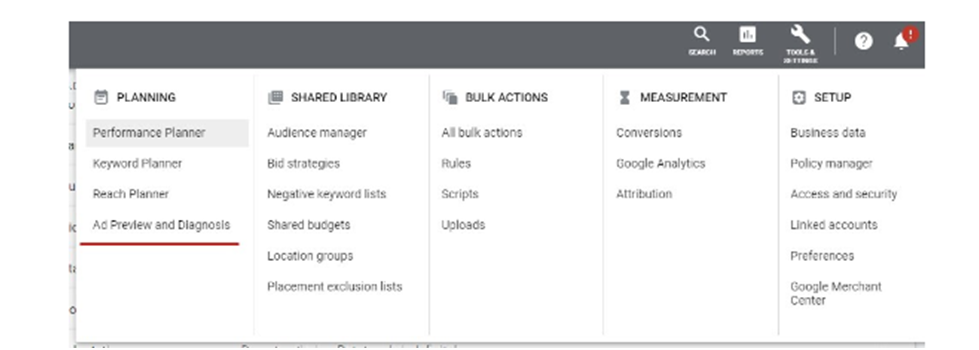
Where are Google Ads headed?
The world of advertising keeps changing by the day. Consequently, Google Ads is anticipated to experience major changes to satisfy the needs of advertisers and consumers. The following are some hypothetical projections for Google Ads and online advertising:
- Voice Search Advertising: Voice search advertising may become more popular as voice-activated technology and virtual assistants proliferate. For voice-based queries, advertisers will need to modify their approaches.
- AI and Automation: Google Ads will increasingly rely on the combination of artificial intelligence (AI) and machine learning. The sophistication of automated bidding, ad copy generation, and audience targeting will increase, enabling advertisers to more effectively optimize their campaigns.
- Personalization: There will be an increase in the use of personalized advertising. Users’ data will be used by advertisers to offer highly relevant adverts that are based on each person’s tastes and behavior.
- Privacy laws: The capacity of advertisers to collect user data and target adverts may be impacted by stricter data privacy laws. Advertisers will need to come up with creative solutions to stay within the law and still deliver successful campaigns.
- Expanded Ad Formats: To stay up with evolving user trends and technological advancements, Google is likely to roll out additional ad places and formats.
How to Prepare for the Future of Advertising
We will be doomed if we fail to prepare for the changes in this sector. We should take the following factors into account to prepare for the changing nature of the advertising industry. These will also help you maintain most Google Ads best practices:
- Learn as you go: To remain competitive, stay informed on market developments, product upgrades, and modifications to Google Ads policies.
- Be Spontaneous in your Tests: Test new approaches frequently, and adjust them to the shifting nature of the digital advertising environment.
- Expand Your Marketing Channels: Although Google Ads is effective, expanding your marketing options will help you reduce the risk of future platform changes.
- Focus on User Experience: To engage and keep customers, place an emphasis on providing a smooth and personalized user experience across all touchpoints.
- Monitor Key Performance Indicators (KPIs) and Performance Metrics: Keep an eye on key performance indicators (KPIs) and performance metrics to spot areas that could use improvement.
Conclusion
Google Ads presents an unparalleled opportunity for businesses to thrive in the digital marketing landscape. It is high time for your business to get ahead of your competitors by doing what they are not doing.
As the advertising industry evolves, remaining adaptable, creative, and data-driven will be the keys to success. By understanding and implementing the key strategies discussed in this guide, you can unlock the full potential of Google Ads.
Embrace change, test new approaches, and always prioritize delivering exceptional ad experiences to achieve remarkable results with your Google Ads campaigns.
Let these insights empower you to take action and drive your business to new heights in the world of digital advertising.
Table of contents
Related Posts
We’ll handle the tech
so you can get on with
running your business.

CALL US
1300 414 214
Our Trusted Partners
Contact Us
Let’s Talk
Common Questions
Do you outsource your work overseas?
No. We use local teams only. That way we can respond more quickly to any problems that may occur. We want your tech running smoothly so you can focus on what you do best.
Is your support 24 hours?
Yes. We have people available whenever you need us. We understand that your tech runs 24 hours, and you need it be working at all times.
Are your services customised for my business?
Yes. There is great off the shelf software. But we know one size never fits all. So anything we set up for you is designed to make your business run smoother and in the way you want it to.
Are your services expensive?
No. Reliable tech is the life blood of your business. We keep it running smoothly so your business can keep making money. All our services are fixed fees, so you never get any nasty surprises.
What’s the next step?
Simply book a chat with one of our experts. We’ll have a chat about exactly what you need and how we can help. If you like our approach then we’ll give you a fixed price quote and get everything up and running for you, fast!



